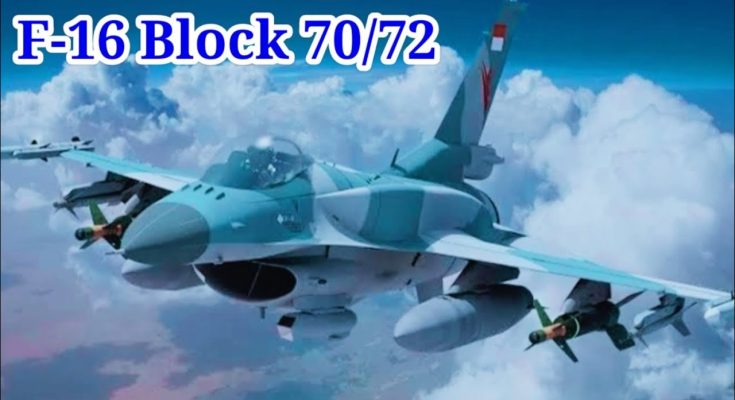The F-16 Fighting Falcon, commonly known as the “Viper,” has long been one of the world’s most versatile and widely used fighter jets. With its remarkable agility, powerful armament, and low operational costs, it has been a cornerstone of many air forces for decades. However, the F-16’s legacy is far from over, as the latest versions, the F-16 Block 70/72, represent the most advanced iteration of this iconic aircraft to date. These models bring cutting-edge technology, enhanced capabilities, and greater survivability to the table, making the Block 70/72 a formidable force in modern air combat.
A Modernized Fighter Jet
The F-16 Block 70/72 is a significant upgrade over previous versions of the F-16, incorporating the latest advancements in avionics, radar systems, weapons, and cockpit design. Developed by Lockheed Martin, the Block 70/72 brings the Viper up to par with the most advanced fighter jets in the world, ensuring its relevance in the evolving battlefield.
One of the most notable upgrades in the Block 70/72 variant is its Active Electronically Scanned Array (AESA) radar, the APG-83. This radar system offers superior performance in detecting and tracking targets at long ranges, even in cluttered environments. The AESA radar allows for better multi-target engagement and enhances situational awareness, providing pilots with a significant edge during both air-to-air and air-to-ground operations. Compared to earlier radars, the AESA is more reliable, provides greater accuracy, and operates more effectively in contested environments.
Enhanced Avionics and Upgraded Cockpit
The cockpit of the F-16 Block 70/72 is another area where this modernized Viper excels. The aircraft is equipped with a glass cockpit featuring high-resolution multifunction displays (MFDs) that provide the pilot with real-time information, including navigation, threat detection, and mission data. This user-friendly design improves the pilot’s ability to manage complex tasks while ensuring they can respond rapidly to changing combat conditions.
In addition to the upgraded cockpit, the Block 70/72 incorporates digital flight controls, which allow for improved handling and stability. The digital flight control system enhances the aircraft’s maneuverability and makes it more responsive to pilot input, making it even more effective in combat scenarios. Moreover, the jet includes a Mission Data Loader (MDL), allowing for easy and quick updates to software and operational systems, ensuring the F-16 can keep up with evolving threats and tactics.
Advanced Weapons and Payload
Another significant improvement of the F-16 Block 70/72 is its ability to carry and deliver a wider variety of advanced weapons. The jet is compatible with modern air-to-air missiles like the AIM-120 AMRAAM, which provide enhanced targeting and engagement capabilities. Additionally, the Block 70/72 can be armed with a variety of precision-guided munitions (PGMs) for air-to-ground operations, including bombs, rockets, and guided missiles. These weapons, coupled with the aircraft’s upgraded targeting systems, allow the Block 70/72 to engage both air and ground targets with high precision.
The F-16 Block 70/72 also boasts an upgraded engine, the F110-GE-132, which provides increased thrust and fuel efficiency compared to older models. This engine allows for better performance, extended range, and enhanced maneuverability, making the Block 70/72 capable of executing a wider variety of missions with greater effectiveness.
Global Demand and Strategic Importance
The F-16 Block 70/72 has quickly garnered attention from numerous air forces around the world, including Bahrain, Slovakia, and Bulgaria, all of which have signed contracts to acquire the aircraft. Its relatively low cost, coupled with its advanced capabilities, makes the Block 70/72 an attractive option for nations looking to modernize their fleets without the high costs associated with more expensive fighter jets.
The F-16’s continued success on the global stage highlights its strategic importance. Its role in air superiority, close air support, and precision strikes makes it indispensable to many air forces, and the Block 70/72 ensures that the Viper remains a relevant and powerful asset for years to come. Furthermore, the aircraft’s interoperability with NATO systems and compatibility with modern weapons make it a key player in coalition operations.
Conclusion
The F-16 Block 70/72 is the most advanced version of the legendary Viper to date, incorporating the latest technology in radar, avionics, weapons, and engines. These upgrades provide the aircraft with enhanced performance, survivability, and versatility, ensuring its place as a top-tier fighter jet in modern combat. As nations around the world continue to invest in this upgraded version of the F-16, the Block 70/72 is poised to remain a critical asset in global air forces, capable of taking on a wide range of missions and providing unparalleled air superiority. The F-16’s legacy is far from over, and with the Block 70/72, it will continue to dominate the skies for many years to come.



